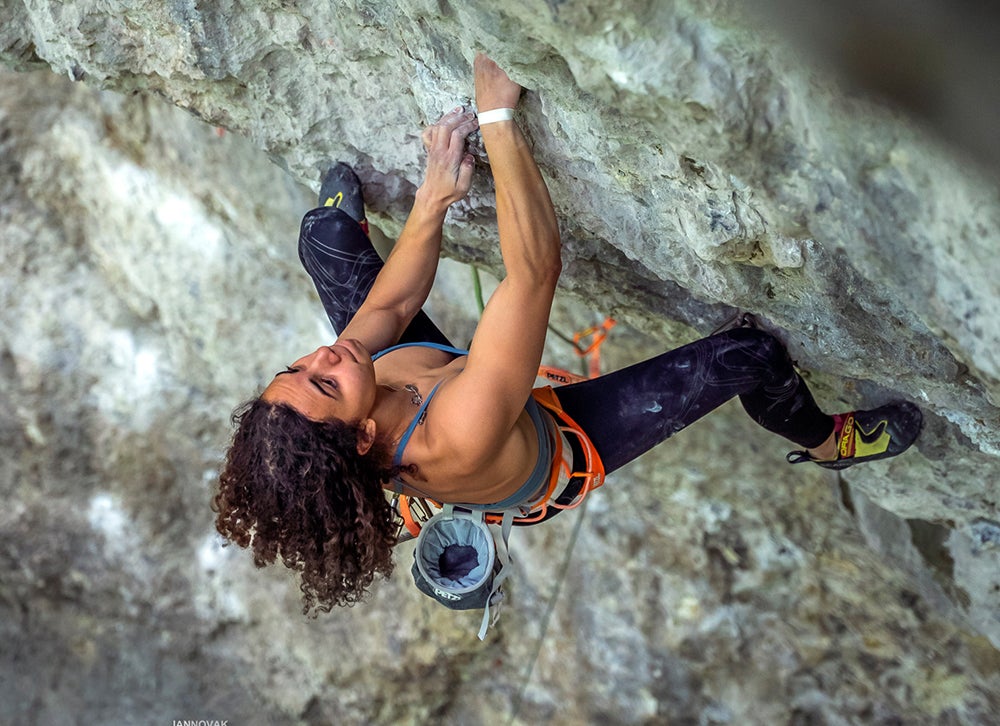4 Surprising Facts For Female Climbers For Better Training And Harder Sending

Molly Thompson-Smith cranking at the Frankenjura, Germany. Female athletes such as climbers have different nutritional needs than less-active women. (Photo: Jan Novak)
- Your menstrual cycle doesn’t impact climbing as much as you think it does
Females have all heard the message: if you want to maximize your training, pay attention to your menstrual cycle. Then you get launched into a tutorial on what the different phases are, what hormones are involved, and how that could affect your exercise. Except a recent meta-analysis, Sports Medicine by Kelly Lee McNulty et al, on the effects of menstrual cycle phase on exercise performance in eumenorrheic women, reveals that there really aren’t too many compelling data to support this idea that you need to train differently according to your menstrual cycle.
Researchers analyzed 51 studies on menstrual cycle and athletic performance. They found that exercise performance may be weaker only by a small margin in the early follicular phase (days 1-5 of your cycle). That’s it.
While it’s true that women have varying experiences with their cycle and its side-effects, there simply isn’t enough research to show that you definitively need to alter training according to your cycle. Some experts recommend only doing certain types of training during different phases. But speaking as one busy woman, who has time for that? It would take a special amount of mental energy and schedule-shuffling to only strength train during the follicular phase, or only do endurance during the luteal phase. Not only that, but skipping certain types of training just because you happen to be in a certain phase may thwart your overall climbing performance.
Researcher McNulty instead recommends exercising according to how you feel. If you’re having a crappy PMS day with headaches and cramps, skip the climbing or practice yoga to work on your flexibility. If you’re feeling awesome, maybe it’s time to send that project.
- If you lose your period that’s really bad
Barring pregnancy or menopause, losing your period is a red flag. Called amenorrhea, this is a sign that your body is not getting enough calories to support normal body processes in addition to your climbing and training. Oligomenorrhea, defined as cycles of 35 days or more, is also concerning for the menstruating climber, as infrequent periods may also indicate energy deficiency. Check with your doctor if this occurs—it may be a sign of an underlying problem such as relative energy deficiency in sport (RED-S). Some doctors prescribe birth control to “restart” your period. This is not appropriate, as it doesn’t fix the underlying problem of why your period is gone, it simply initiates a withdrawal bleed. Still worse, other doctors dismiss a missed period as normal for an athlete. If this is the case, seek out a doctor that will help you. You’ll likely need the assistance of a sports dietitian as well.
- You probably need to eat more than you think
You’re a serious crusher with serious projects. You need serious calories to fuel your climbing dreams. What little research we do have on dietary intake in climbers shows that climbers chronically under-eat. Females are at higher risk for eating disorders, compromised bone mineral density, iron deficiency, and under-fueling. Eat consistent, full meals with pre- and post-climbing snacks. Give your body the energy it needs to meet your climbing demands.
- You may need more iron
Since females lose iron with menses, they need more iron that non-menstruating individuals. The current recommendation is 18 milligrams of iron per day for females, and about 23 to 30 grams for vegans and vegetarians. Good sources of iron include shellfish, beef, lentils, pumpkin seeds (pepitas), quinoa, turkey, fortified grains, and dark chocolate. If you have an iron deficiency, then you need an iron supplement as it’s tough to correct a deficiency through diet alone. Ask your doctor what dose and form of iron is right for you.
Author’s note: For the purposes of this article, “female” and “woman” refers to female assigned at birth who has not undergone any gender transition. The nutrition information presented is aimed at those not currently pregnant or breastfeeding.
Marisa Michael, MSc, RDN, CSSD is a board-certified specialist in sports dietetics and author of Nutrition for Climbers: Fuel for the Send. She serves on the USA Climbing medical committee and has a private practice in Portland, Oregon. Find her online at nutritionforclimbers.com or on Instagram @realnutritiondietitian for nutrition coaching, workshops, and writing services.